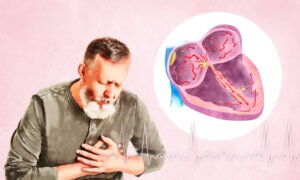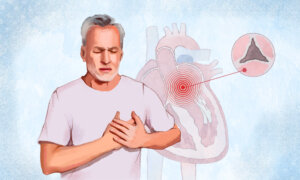Millions of Americans are unknowingly putting their heart health at risk because of undiagnosed obstructive sleep apnea (OSA).
This common yet serious breathing disorder doesn’t just disrupt sleep—it can also lead to life-threatening complications such as heart failure, arrhythmias, and even sudden cardiac death if left untreated.
Why Doctors Often Miss Sleep Apnea
OSA is a disorder in which the airway in the throat collapses and breathing stops intermittently, causing blood oxygen levels to drop during sleep. Statistics show the disorder affects
26 percent of adults between the ages of 30 and 70.
The current number of people with sleep apnea may, however, be underestimated, as some people with the disorder remain undiagnosed. Symptoms such as snoring, pauses in breathing, and poor sleep quality can go unnoticed during the night.
Underdiagnosis is often a result of physicians not always thinking to ask about sleep, Dr. Tiffany Di Pietro, a board-certified cardiologist, told The Epoch Times.
“When patients say they are fatigued, for instance, we immediately jump to thyroid or being too busy,” Di Pietro said. “In reality, if a patient is not sleeping well, the main symptom could be fatigue.”
How Sleep Apnea Changes Heart Structure and Function
While OSA can cause excessive daytime fatigue, its effect over time can manifest into severe heart function problems. The exact reasons aren’t entirely understood, but according to Di Pietro, the mechanisms are likely multifactorial.
“We believe that having low oxygen saturations at night activates our sympathetic nervous system, which increases blood pressure,” she said. “The same oxygen decrease causes the heart to lack appropriate oxygen (similar to a blockage), therefore causing arrhythmias and a decrease in the ability of the heart to contract correctly.”
When left undiagnosed, sleep apnea can cause structural changes to the heart. OSA can increase the thickness of the heart walls and heart muscle stiffness, eventually leading to congestive heart failure, Dr. Tracy Paeschke, a board-certified cardiologist and health coach specializing in integrative cardiology, told The Epoch Times.
“Sleep apnea increases the pressure in the lungs,” Paeschke said. Over time, this increased pressure can change the structure of the left atrium, one of the heart’s four chambers, and eventually lead to atrial fibrillation, the most widely diagnosed heart arrhythmia in the world, she noted.
Di Pietro said effectively treating atrial fibrillation in patients with OSA requires first addressing the underlying sleep disorder. Common treatments, procedures, and medications are significantly less effective if the patient’s sleep apnea remains untreated.
“The low oxygen levels will predispose the patient to develop the arrhythmia again,” Di Pietro said. “I give my patients the analogy of atrial fibrillation being like a leaky roof—just because you fix one leak doesn’t mean another can’t pop up somewhere else.”
Inflammation, Atherosclerosis, and Sudden Cardiac Death
OSA also increases the risk of
cardiovascular disease by increasing inflammation. This can lead to plaque build-up in the coronary arteries and arteries throughout the body, including the brain. Plaque build-up, known as atherosclerosis, is a known cause of heart attack and stroke.
Patients with OSA have higher levels of inflammatory proteins and markers, which can damage the protective lining of the arteries, according to Di Pietro. “These patients have higher levels of endothelin and lower levels of nitric oxide, potentially causing inflammation leading to arterial injury and cardiovascular disease,” she said. Endothelins, a family of peptides that contain 21 amino acids, can raise blood pressure.
According to research published in Circulation Reports, there is “biologic plausibility” that there is a connection between OSA and sudden cardiac death—an event during which the heart stops beating because of an irregular rhythm. Breathing and blood flow stops, and death occurs within seconds.
Proper treatment of OSA cannot only manage but potentially reverse associated heart conditions, according to Paeschke. “Treatment can decrease the wall thickness and stiffness of the left ventricle and elevate pulmonary and left atrial pressures, all of which can lead to a reversal of heart failure,” she said.
Given this potential for reversal, Paeschke emphasized the importance of early recognition, accurate diagnosis, and prompt treatment of OSA.
OSA Signs and Symptoms
Recognizing OSA symptoms can be tricky since many of them happen during sleep.
Most people who’ve heard of sleep apnea only think about snoring as a symptom. “Someone can snore and not have sleep apnea or not snore at all and have sleep apnea,” Di Pietro said.
“The biggest symptom is waking up tired or feeling tired in the afternoon for no reason.” Waking up with a dry mouth or headache is notable, but if someone is waking up choking or gasping for air, it should send up a “big red flag,” she added.
A significant physical sign of sleep apnea is obesity. Obesity can cause fat deposition in the neck, increasing upper airway collapse. Fat deposits around the chest may make it harder to take deeper breaths and increase oxygen demand during sleep.
According to Paeschke, other physical signs that can help identify someone who might have or is at risk for sleep apnea include a thick neck, poor posture with a head-forward profile, a small mouth, a large tongue or tonsils, and living at a high altitude.
Diagnosis and Treatment
Screening for OSA is usually the first step toward a diagnosis. Doctors use various questionnaires to assess a patient’s risk, focusing on common symptoms such as snoring, daytime fatigue, interrupted breathing during sleep, and high blood pressure. If these initial screenings suggest OSA, the physician will assess other risk factors, including body mass index, age, neck circumference, and gender.
A formal diagnosis requires a polysomnogram, commonly known as a sleep study.
“There are home sleep studies and in-office sleep studies, the latter being more detailed and accurate,” Di Pietro said. These tests measure critical indicators such as oxygen saturation, breathing rate, and heart rhythm during sleep.
Once there is a definitive diagnosis of OSA, continuous positive airway pressure (CPAP) is the gold standard for treatment, according to Di Piero. The CPAP machines deliver pressurized air through the mouth or nose, keeping the airway open.
“It’s our first-line treatment due to its proven efficacy in managing sleep apnea, ”she noted.
However, some patients struggle with CPAP therapy, finding it difficult to sleep with a mask.
“For those patients, there are other options such as mouthpieces or oral devices designed to be worn in the mouth to bring the lower jaw forward to help relieve the obstruction or keep the tongue from falling back while sleeping,” Di Pietro said. In some cases, surgical options such as airway stimulation devices may be considered to improve breathing during sleep.
Paeschke said diet and exercise can significantly improve OSA through weight loss. “By making healthy lifestyle choices, you can effectively manage your condition.”









